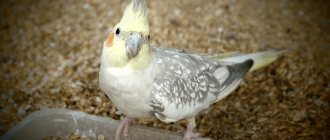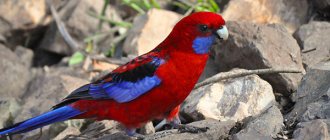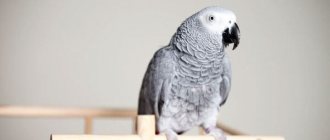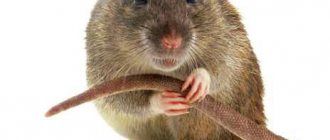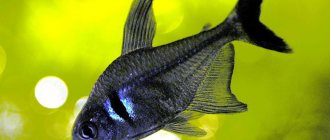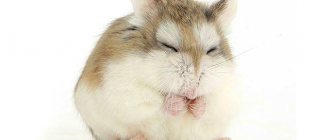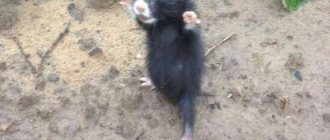09 November51466decorative birdscorellacockatooparrot
The cockatiel is a talking parrot from the cockatoo family, also called a nymph. This charming bird is native to Australia. The Corella parrot will be an excellent pet that will delight you not only with its exotic appearance, but also with its singing abilities. In this article you will learn how to tame a cockatiel and teach it to speak, and also find useful information about keeping a cockatiel.
About Corella parrots
This is what the Corella parrot looks like photo
The Corella parrot resembles a cockatoo in appearance, whose head is decorated with a beautiful crest. In the wild, their feathers are gray. This is what a cockatiel parrot looks like, you can see the photo above.
origin of name
— Advertising —
Photo of cockatiel
The homeland of cockatiels is Australia. This is how these feathered pets were dubbed by the indigenous inhabitants of the continent. Translated, this name means “like an eagle,” and most ornithologists are inclined to believe that cockatiels were the ancestors of eagles and hawks.
Interestingly, another name for the bird came from Europe. When travelers first saw these graceful birds, they mistook them for gray nymphs, who were considered by the Greeks to be eternally young goddesses of the life-giving forces of nature. Since then, scientists have called the cockatiel a nymph (Nymphicus hollandicus).
The first description of these Australian parrots was given by the Scottish naturalist Robert Kerr in 1793. And in 1840, the first individuals left the mainland on the ships of seafarers and conquered Europe with their appearance and charm. Since 1848, offspring began to be obtained from adult birds in captivity.
Appearance
— Advertising —
Appearance of cockatiel photo
The body of a medium-sized cockatiel parrot, including the tail, is 30 cm. At the same time, the pointed tail is half the length of the bird, and the weight rarely exceeds 100-120 g. You can see a photo of the cockatiel parrot above. The wingspan is from 30 to 35 cm. There are bright spots in the parotid area, and the beak has a neat shape and is slightly curved down, with visible plumage under the nasal openings. With good home maintenance and proper diet, the beak remains smooth, hard and shiny, without signs of delamination and wax growth.
At a young age, birds do not differ in plumage color. But then the males acquire a more saturated olive-gray color. The small head is crowned with a yellow crest. The color of the female's plumage, legs and rings surrounding the eyes remain gray, but the crest and head have a yellowish tint, and the top of the tail and the lower part of the back may be covered with brown pigment. The eyes of cockatiels always remain dark brown, and there are round orange spots on the cheeks that distinguish this bird from other cockatoos.
Corella is a songbird with a rather melodious voice. They sing well and also easily parody human speech, the sounds of household appliances and pets.
The variety of colors is due to the artificial breeding of cockatiels, since it is currently prohibited to export these birds from Australia. Breeders have bred more than 20 species of cockatiels of a wide variety of colors. In addition to colorful parrots, you can also find black and white nymphs.
A little history of the species
The homeland of cockatiels is Australia. Animalist and ornithologist John Gould undertook a zoological expedition to the mainland in 1838–1840. He took out about eight hundred birds and seventy animals. Upon returning to Great Britain, the scientist systematized his works, the result of which was the book “Birds of Australia”. In the part dedicated to parrots, the ornithologist tells everything about cockatiels: their lifestyle, appearance.
Europe first saw cockatiels in the forties of the nineteenth century. From Paris, the birds, through the efforts of private breeders, spread throughout the European part of Eurasia. After 1960, Australia introduced a ban on the export of parrots outside the country. Further breeding and selection took place without the participation of wild representatives.
Behavior and diet
The photo shows a gray and white cockatiel.
Corellas love to watch people's actions and are easily involved in games; they are very active and curious. However, to maintain such energy, birds need the right diet.
In the wild, parrots prefer the leaves of eucalyptus trees and shrubs, juicy fruits and herbs. They also love nectar, seeds, resin and young bark of many woody plants.
At home, they should receive a similar diet. It should include fresh vegetables, fruits, herbs and grains. Occasionally it is necessary to add a boiled egg and low-fat natural cottage cheese to the food.
Details and subtleties of handling
In order for your pet nymph to be healthy, playful and funny, it is important to handle it correctly. For example, it is not recommended to catch a parrot with your hands, because this greatly frightens the bird and then makes it more difficult to gain its trust.
The best way is to open the cage and wait until the bird flies into it to eat, rest or sleep. You should not try to remove the parrot from its cage against its will.
It is very important to develop a close relationship with your Corella parrot, spend more time near the cage, and it is strictly forbidden to frighten him with knocks and sudden movements.
Habitats
Photos of gray cockatiels
Nymphs are indigenous to Australia. Their main habitat is eucalyptus groves in river floodplains, as well as fertile steppes, in which there are enough solitary trees and tall shrubs. Small groups of cockatiels live in semi-deserts.
During the breeding season, cockatiels break into pairs, hatch chicks and take care of their offspring. The rest of the time they unite in flocks of 10-15 individuals. If the year is excessively dry, parrots move in large numbers closer to bodies of water.
On other continents, cockatiels are not found in the wild, although they are very popular to be kept instead of budgies in North America, Asia, Europe and in our country. Domestic parrots that fly away from their owners are not able to survive in the wild on their own. Therefore, you need to ensure that feathered pets do not have the opportunity to fly out of windows or doors into the street.
How to tame a cockatiel?
It’s easy to tame a cockatiel, the main thing is to be patient and give the parrot enough attention so that it gets used to your company. It is quite natural that your feathered pet will not immediately feel comfortable in a new environment. Do not bother the parrot in the first few days after moving in, give it time to calm down and look around. This way he can quickly get used to the new environment. Then you can start communicating with your pet. At first, try to limit the access of other pets to where the cockatiel is.
To tame a cockatiel, the bird must trust you. Don't try to force her out of her cage. Try feeding your pet from the palm of your hand, handing it some kind of treat, calmly and affectionately repeating the bird's name. Try not to make sudden movements and make sure that your palms do not have any foreign odors.
If everything is done correctly, the Corella parrot will feel safe and after a while will become completely tame. Taming a cockatiel will not be difficult, because it is an active, sociable bird that loves attention to itself. Don't forget to communicate with your pet to make him feel happy.
The Corella parrot is a kind, naive and open bird, which is not characterized by aggression. If suddenly a cockatiel parrot begins to bite, then this is a signal that something is wrong with it. Perhaps the bird is stressed, he is sick or he doesn’t like something. By biting the parrot is trying to tell about any problems. Try to recognize what's wrong. Do not forget that the cockatiel does not like strong odors such as tobacco, air fresheners and perfumes, as well as loud sounds, which frighten her very much. If the reasons have not been identified, and the bird’s behavior does not change for the better, then you should seek help from a veterinarian.
Migratory or wintering
The photo shows a yellow cockatiel on a branch.
Corellas are capable of covering considerable distances, but they are not migratory birds. In winter in Australia, the thermometer does not drop below 0°C, so birds can easily cope with this time of year. In addition, winter is considered the rainy season, when plants receive sufficient moisture and increase their growth, providing food for birds.
Cockatiels were forced into Europe on ships, but not a single bird left Australia on its own.
Reproduction
In nature, the nesting cycles of the cockatiel depend on the rainy season. This is due to the fact that it is easier to raise chicks when there is an abundance of water. All species of cockatiels breed twice a year: the first clutch is usually incubated in the fall, the second in mid-winter. The female lays five to seven eggs, which are incubated alternately with the male for 21 to 23 days. The parents feed the hatched chicks until they are approximately two months old, then the older generation leaves the nest. Having rested, the couple begins a new laying.
Corella parrot chick
A married pair of tame parrots can reproduce freely if favorable conditions are created:
- closer to autumn (or spring, if this time of year is chosen), you should start feeding the birds with a special vitamin mixture;
- add sprouted grains and calcium to food;
- gradually increase daylight hours to 16 hours;
- You need to prepare a nest box (house) in the cage.
Individuals must be at least two years old and not older than six years old. Inbreeding is undesirable, otherwise you may end up with defective, sick chicks with defects.
Species (subspecies)
Photo of a light gray cockatiel
The only species of cockatiel that lives in natural conditions has a light gray or dirty gray color. But thanks to breeders, new varieties of nymphs of different colors were bred in captivity. Currently, there are eleven main color variations of cockatiels, and some even have their own subspecies.
Albino Corella
Photo of an albino cockatiel.
A distinctive feature of this species is the white color of the plumage of the female and male and red eyes. A slight creamy coating is allowed, but the yellow color of the head feathers and crest is retained.
Males always have snow-white feathers, but females may have slightly yellowish spots on the wings and under the tail, which create a marbled effect.
To produce albinos, breeders crossed lutino with parrots that have a white head.
The albino cockatiel subspecies includes the white nymph, which has black eyes and a clearly visible yellow coating on its plumage. Interestingly, the two longest tail feathers in males are snow-white in color, while the rest remain slightly yellowish. In females, the tail is yellow and the undertail is marbled. When obtaining this subspecies, they were used to cross white females and gray males, who are carriers of the whiteness gene.
Lyutino
Photo of Corella Lutino
Corella Lutino is characterized by red eyes and deep yellow feathers. In adults, the eye color changes to dark cherry. There is spotting on the wings and back, but the color contains only various shades of yellow, which determines the name of the species.
On the light yellow plumage of the dewlap there is a kind of ladder of more clearly visible spots. This is considered a disadvantage of the breed, so breeders are looking for crossbreeding variations that will make it possible to get rid of it.
In male lutinos, the “blush” on the cheeks must be orange.
Sheki
Photo of Sheki cockatiel
Sheki are the most popular and expensive varieties of cockatiels. They are distinguished from other species by the presence of white spots on gray feathers. The symmetrical arrangement of spots, as well as the presence of gray and white in equal proportions, are especially appreciated.
Sheki have gained great popularity among breeders, as they are recognized as the best source material for breeding new subspecies. An example of this breeding is the Pearl Neck, which has an all-white head, a yellowish-tinged tail, and iridescent gray feathers on the back and wings. Interestingly, in adult females the color remains even after molting, while in adult males the color changes to the classic shek.
Among this subspecies of nymphs there are “harlequins” with gray wings, a yellow head and crest feathers. The rest of the body, neck and legs are white.
Cinnamon colored cockatiel
Photo of a cockatiel with a brown tint.
In the body of parrots, under the influence of enzymes, a black pigment is formed. Due to the failure of biochemical processes, the cinnamon-colored nymph produces more of these enzymes than the gray-colored cockatiel. As a result of crossing them with lutino, individuals with varying degrees of intensity of brown color are obtained.
From birth to 3 months, the eye color of the chicks remains red and then darkens. In adult birds, the beak and pink feet also gradually become darker.
In addition to the varieties described, the following subspecies of nymphs are distinguished:
- black;
Photo of black cockatiel
- light and pearl gray;
Photo of a light gray cockatiel
- dark yellow;
Photo of dark yellow cockatiels
- white- and black-winged.
Photo of a white-winged cockatiel
Subtleties and nuances of care
The most important thing that the owner of a bird should never forget is its Australian origin, therefore care, care and warmth are the main components of its daily life, which the owner must provide.
The most optimal temperature for keeping a Corella parrot is approximately 20 degrees. If this figure is a little higher, that will also be good. And vice versa, if this temperature is lower, then it should be raised artificially, using a heater or a special lamp. But in such a situation, it is also necessary to take into account the air humidity in the room, on which the health and general good condition of the bird directly depends.
A sufficient amount of fresh air is another serious issue on which the health of the parrot depends. But here you should be careful that, along with fresh air, there are no dangerous drafts in the room that could seriously harm your pet.
Female and male
The photo shows a female and a male cockatiel.
Sexual dimorphism in cockatiels is weakly expressed. The male Corella is colored in richer shades and has distinctive white stripes on its wings. The plainness of the female’s coloring can only be noticed in comparison with an individual of the opposite sex. She also has transverse pale yellow stripes on her tail, and oval spots of the same color can be found on the inner surface of her wings. Young individuals retain the same color as their mother until the completion of the juvenile molt. However, after molting at 9-12 months, it changes in males.
In cockatiel chicks, sex can only be determined by behavioral reactions. Adolescent males sing loudly, bang their beaks on hard surfaces, straighten their shoulders and stomp, trying to attract the attention of females. Those, in turn, behave modestly, take a low posture and throw back their heads, showing their readiness to submit to the male.
Tips for buying a parrot
When choosing a parrot in a nursery or elsewhere, the sex of the bird can be determined by its color and behavior. As a rule, before 1 year of life, it is very difficult to do this without being a specialist. In this case, it is necessary to take into account that males are noisier, often knock with their beaks, and also make more complex sounds.
Where to buy and what to look for
The Corella parrot can be purchased both in a nursery and from a private breeder. If the parrot is healthy, it has a beautiful and neat appearance, with even plumage that fits tightly to the body, clear eyes and an excellent appetite. The bird is quite active and “verbose”.
If a parrot nervously rushes around in the cage, screams loudly, scratches itself or pulls out feathers, then this is the first sign that something is wrong with the parrot and you should absolutely not buy it. You cannot buy very apathetic individuals, depressed, ruffled, losing coordination or falling over on their side.
Corella parrot price
Australia is considered the homeland of Corella parrots and their export from the country is prohibited by law, so only birds artificially bred in nurseries or from private breeders are sold. The cost of a parrot is not exorbitant, but quite affordable, due to the simple breeding process. For a parrot, 3 months old, you will have to pay an average of 3 thousand rubles.
Keeping at home and breeding
Photo of a yellowish cockatiel sitting on a glass
Despite the fact that a hot climate prevails in the homeland of cockatiels, it is best to maintain the room temperature from 18 to 25°C. Even a temporary decrease in indicators to +10°C will not have detrimental consequences for the health of the bird. However, exposure to frost or draft will quickly lead to illness or death of the nymph.
The average daylight hours should be 14 hours in the warm season, and 10 hours in the cold season. It is also useful for cockatiels to turn on a UV lamp.
Information about cockatiel parrots when kept at home
and a Gray-yellow cockatiel sits on a branch photo
In order for your feathered pet to quickly get used to its new place of residence, you must choose and equip its cage correctly. For one bird, the dimensions should not be less than 50x40x60 cm. For a pair of nymphs, larger cages are needed, measuring 150x60x90 cm.
It is advisable to release parrots daily so that they have the opportunity to fly freely and walk around the house for 1.5-2 hours. If this is not possible, you should purchase a cage in which the birds can fly from place to place.
The bars of the cage should not be painted, since paint can cause poisoning if it enters the bird’s stomach. Inside, the nymphs' home should be equipped with several perches, feeders and drinkers attached to the walls. It is advisable to hang “bird” toys, a mirror and a bell. At the bottom you should put branches of woody plants treated with boiling water and place a bowl with sand.
Corellas love to swim, so you need to put a bathing suit with water in the cage. Clean up as it gets dirty, promptly discarding droppings, fallen feathers and leftover food.
How to feed your pet cockatiel
In the photo, a female and a male cockatiel are feeding on a mineral stick.
To provide the cockatiel’s body with a sufficient amount of energy and maintain health, you should give them succulent and grain-based foods, and also periodically introduce vitamin and mineral complexes into the diet.
Grain mixtures must contain the following components:
- millet;
- oats;
- corn;
- wheat;
- sunflower seeds;
- flax seeds and weeds.
It is best to purchase balanced special food intended for parrots in specialized stores.
Corellas love juicy fruits and berries. Citrus fruits and unroasted nuts can be given occasionally. Among vegetables, nymphs prefer zucchini, carrots, and pumpkin, and among greens, lettuce, spinach, young shoots of dandelion and beets.
For protein foods, you should choose low-fat cottage cheese and hard-boiled eggs. In the autumn-winter period, nymphs should be given branches of pine needles and rowan 2 times a week.
Breeding information
Photo of a gray-yellow cockatiel
Corellas can easily reproduce at home if they are provided with proper care and nutrition. The optimal breeding period is from May to October. Only healthy birds with no visible signs of disease should be brought together. A special house must be placed in the cage, where the females build nests and lay eggs.
Parents alternately warm the clutch of eggs, from which chicks emerge after 20-23 days.
In the first days of life, females feed the chicks with “fore stomach milk”, which is a yellowish liquid. On the 3-4th day, they begin to feed the cubs solid food, which they first swallow, partially digest, and then regurgitate. After 2 weeks, babies can absorb small pieces of food on their own. And by the beginning of the second month of life, they leave the nest and try to fly.
During the breeding period, difficulties with the health of the female and babies may arise, so as an alternative, you can buy a chick from an experienced breeder.
What to feed your cockatiel?
Cockatiels should be fed a balanced diet based on grain mixtures. You can also feed your cockatiel with sesame seeds, oats, boiled corn, sprouted wheat, raw sunflower seeds, and pumpkin seeds. In addition to grain food, cockatiels eat various vegetables and fruits: beets, carrots, zucchini, tomatoes, cabbage, cucumbers, apples, pears, melons, pineapple, banana, kiwi, grapes, peaches, apricots and pomegranate.
You can also give your cockatiel greens (lettuce, carrot and beet tops, plantain, clover, dandelion leaves) and berries (cherries, strawberries, raspberries, blackberries, gooseberries, currants), low-fat cottage cheese, and a boiled chicken egg. No matter how balanced the diet is, we should not forget about various vitamin and mineral supplements. Birds should always have clean water. Corella should not be given too fatty foods, as well as fried and smoked foods, chocolate, mushrooms, avocados, onions and garlic.
Interesting Facts
Photo of a cockatiel on a cage
There are several interesting facts that colorfully characterize cockatiels:
- The nymph's intelligence is identical to the mental development of a 3-4 year old child.
- A parrot raised in captivity becomes completely tame, considering a person a member of its family.
- In the wild, a cockatiel sitting on the ground will not allow a person to approach it, but when it is on the branches of trees, it can safely allow people to touch it.
- Nymphs recognize about one and a half hundred different images per second, while humans recognize only 16.
- There are schools in Australia that teach cockatiels and other parrots to talk.
- Nymphs do not have vocal cords, and they produce sounds only with their mouths.
- Depending on which paw the cockatiel takes food with, it can be considered right-handed or left-handed.
Intelligence and character
All types of cockatiels are recognizable due to their unpretentious and friendly personality. Birds get along easily with humans and are smart conversationalists. It is not their behavior to be aggressive towards people or their own kind. They quickly learn individual words and phrases and are able to remember melodies (the opposite of a lovebird).
The optimal vocabulary of a cockatiel is 200-300 words. Like any animals and birds, cockatiels can be trained using the gingerbread method. They reproduce with detailed accuracy the sounds of household noise, such as opening a door, a doorbell, or a telephone. In this they are similar to their closest cousins, the cockatoo, the rosella or the Indian necklace.
In order to teach a Corella to speak, you need to buy a chick in childhood and it is best that it is immediately accustomed to being handled. They remember well the sounds with which they associate a certain room, time or action. If you tell your pet a story, the cockatiel will forget it the next day.
For example, the phrase “Good morning” is said only before feeding. If you repeat it repeatedly throughout the day, she will simply say it mindlessly. For every attempt, even if it’s not clear, reward him with a treat or a pat on the neck.
The Corella parrot remembers its name faster with the accompaniment of voicing actions (Kuku eats, Kukku goes to bed, etc.). Parrots are very affectionate towards their owners and treat them as members of the flock. Males, as a rule, are more active than females, whistle and their chirps are more melodious. Breeding requires extreme caution and attentiveness on the part of the owners. If the very nature of pets is kind to humans, this does not mean docile behavior when there are a large number of birds in a confined space.
Singing
Both in natural and at home conditions, the cockatiel sings very melodiously, accurately repeating the sounds it hears. Nymphs easily copy the sounds of alarm clocks, household appliances and other pets. But teaching them to talk is a little more difficult. To do this, you need to show self-control and patience.
Male cockatiels sing especially beautifully during the mating season. At this point, it is easiest to teach the cockatiel to repeat sounds, as well as melodies. To do this, you should hum or whistle simple songs several times a day.
How to teach a cockatiel to talk?
Teaching a cockatiel to speak is very simple. After all, a cockatiel is a talking parrot that can learn up to 300 words. The main thing is to take time and be patient. You should start training only after the pet has settled into its new home and you have established contact with it. Choose a word to learn. It is best that the first word you learn is the name of the parrot.
To teach your cockatiel to speak, you need to pronounce a word or phrase clearly and evenly. You should not speak too loudly, as this may frighten your pet. During training, be sure to look at the parrot, so he will understand that he is being addressed. Dedicate no more than half an hour a day to such activities, just try to do them at the same time.
To teach your cockatiel to speak, it is very important to maintain regular training, as the result depends on this. Also remember to praise your parrot and reward him with treats. Believe me, the result will not be long in coming, and your pet will soon delight your ears with the word it has learned. Be careful and try not to use swear words around the parrot, otherwise he will please you with this too.
If, while bathing or feeding the cockatiel, you repeat a phrase that characterizes the action, then the bird will sooner or later comment on the event itself. The cockatiel can also sing and repeat the melodies it hears. For example, she might repeat a cell phone signal that she hears frequently.
The nymph parrot is unique in that it can both speak and sing. You can choose a song and play it for your parrot every day. This way the cockatiel will quickly learn the melody and will soon perform a familiar tune. As you can see, teaching a cockatiel to talk is easy.
The cockatiel parrot laid an egg: what to do?
First of all, be happy, because cockatiels think about their offspring when everything is good for them: food, water, air, sun - everything is there and there is nothing to worry about.
But it is still important to understand:
- The bird has reached reproductive age and is ready to reproduce. If you are not interested in increasing the number of birds , then it is better to immediately take this egg, like all subsequent ones. The young mother, of course, will not like this, but, as they say, time heals and puts everything in its place. The laying will stop over time
- If breeding is planned , then the female must sit on the eggs for the prescribed 2.5-3 weeks to practice. If you are afraid that they will spoil, you can replace them with plastic simulators. As a result of this, the female will be mentally calm and will acquire the necessary skills later.
Corella laid eggs
Owner reviews
Corellas deservedly enjoy high popularity among domestic lovers of feathered pets. Such a bird is quickly tamed and is also capable of learning individual words or entire phrases quite easily. To be fair, it should be noted that the cockatiel's vocal performance is absolutely not up to par.
Important! It is not recommended to make such a bird angry, because when angry the cockatiel makes very loud, ear-piercing and extremely unpleasant screams.
The sounds that such parrots make are very annoying and monotonous. However, males are able to sing very well, and perfectly imitate the voices of a tit or nightingale . According to the owners, the cockatiel expertly begs for pieces of food from the table, and also quickly learns to open the locks on the cage in the absence of the owner.
Features of keeping cockatiels
This type of parrot is especially popular. With proper care and care, these amazing birds begin to talk and sing. In order for the cockatiel to feel good, it needs to be equipped with a large cage, at least 60 cm high, 40 cm wide and about 1 m long. The material of the rods is stainless, unpainted steel. It is best to buy cages with a retractable tray - this greatly simplifies the cleaning process.
Inside the cage there must be perches or branches on which the parrots will sit. You should also place a couple of swings and ladders. Mandatory attributes for any bird are a water bowl, a feeder and a house. Before using the cell and all components, be sure to carry out processing, i.e. Treat everything you bought to keep your cockatiel with hot water and soap. With proper care and care, the life expectancy of parrots is about 25 years.
Life expectancy and disease prevention
With proper care, Corella parrots live up to 20-25 years. In conditions of unsanitary conditions and nutritional deficiencies, birds can develop the following diseases:
- avitaminosis;
- obesity;
- gastroenteritis;
- dysbacteriosis;
- amyotrophy;
- violation of the structure of the beak and bones;
- parasitic infestations;
- feather loss and self-plucking.
To prevent the development of health problems, birds are provided with regular hygiene, adequate nutrition and timely veterinary care.
Important! If your cockatiel has growths on its beak, constipation, diarrhea, vomiting, baldness, inflammation of the skin, rapid or difficult breathing, the parrot should be immediately shown to a specialist.
History of the origin of parrots
Corella is a small bird from the cockatoo family with a body length of no more than 33 cm (from the top of the head to the tip of the tail), weighing about 100 grams and a long tail - 16 cm. A characteristic feature of the bird is a large crest on the head. The color of females and males is different.
Corellas come from Austria and prefer to live in the arid regions of this country, as well as on plains and along the shores of lakes and rivers. They live all year round in small groups, from 10 to 50 individuals, not counting the period of active reproduction. If the year turns out to be dry and hot, then they accumulate near the nearest bodies of water in large numbers.
Appearance and color
The coloring of cockatiels helps them remain invisible in the Australian wild forests. They usually live in trees, only briefly going down to drink water and plow in the grass.
The body length is approximately 30 cm, the tail length is 15 cm on average. The wingspan is about 17 cm. A noticeable feature of the appearance is the crest - it attracts attention and makes the appearance somewhat similar to a cockatoo. Interesting fact: the cockatiel's crest hides his bald spot - which is quite normal.
There are a huge number of color options, even albinos are found. Males are usually brighter than females.
The nymph is associated with the cockatoo because of its beak - although it is smaller, it is also quite strong. If desired, the cockatiel can bite the wire; it is not for nothing that the bird is called “flying wire cutters.”
What to look for when choosing a cockatiel
- If you need a parrot for entertainment, then you need to choose a young bird, about a 5-6 week old chick. You need to spend a lot of time with her so that she gets used to you faster. If you cannot communicate with the bird often, then choose a female or male for it.
- When choosing a cockatiel, you need to watch it. A bird that sits ruffled, with its eyes closed and on two legs, is most likely sick. Examine her ears, lift the feathers, there should be no signs of inflammation.
- In a good bird, the chest frame cannot be felt. If the chest contour protrudes, it means the bird was poorly fed, and this will lead to the development of various diseases.
- The cockatiel's feather cover should be uniform, without signs of tuft loss. If the feathers do not fit tightly and stick out, the parrot is infected with parasites.
- The bird's anus should be clean and free of redness.
The appearance of offspring in a cockatiel
The cockatiels take turns incubating the eggs and feeding the chicks. Typically, males incubate the eggs during the day and females incubate them at night. By the time the chicks begin to be born, the female sits more on the eggs.
Corella chicks are born covered with thick yellow down. When demanding food, they make an unpleasant sound, so those owners who plan to breed cockatiels need to be prepared for the fact that this will hurt their ears.
When the last chick is born, the cockatiel's parents leave the nest often enough to get food for intensive feeding of the fledgling babies. When they fly away at night, the chicks remain in the nest, huddled closely together, thereby keeping warm. At the age of two weeks, they are overgrown with dense gray down, and their wing covers partially open.
At the age of 35-40 days, cockatiel chicks leave the nest for the first time. At this time, they are already feeding on their own, can sit down and hold on to a perch, flap their wings and try to fly around the cage.
Corella parrots feed their babies from 2 weeks to two months of age. Often the female immediately starts the next clutch and stops feeding the chicks. In such cases, young nymphs need to be removed and fed artificially.
At the age of 4-10 months, young cockatiels begin their first molt, which lasts about five weeks. After this, you can determine the sex of the parrot. The difference between a young male and a female is that the “boys” try out their voices and sing melodic songs, while the “girls” do not do this.
Determining the sex of the bird
You already know that they reproduce well in captivity. It is easy to distinguish a girl from a male by the color of the plumage of the head.
Gender of the cockatiel
In males the head color is yellow, in females it is gray.
Cockatiel chicks, until they molt a couple of times, are yellow in color, so it is difficult to determine the sex. But there are some behavioral signs. Boys develop faster, they are more active, they begin to chirp earlier and beat their beaks on the floor of the cage. Girls are calmer.
And remember - we are responsible for those we have tamed!
